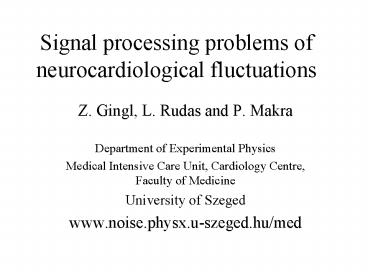Signal processing problems of neurocardiological fluctuations - PowerPoint PPT Presentation
1 / 17
Title:
Signal processing problems of neurocardiological fluctuations
Description:
Medical Intensive Care Unit, Cardiology Centre, Faculty of Medicine. University of Szeged ... Theoretically both linear and spline are inexact. Sampling theorem says: ... – PowerPoint PPT presentation
Number of Views:30
Avg rating:3.0/5.0
Title: Signal processing problems of neurocardiological fluctuations
1
Signal processing problems of neurocardiological
fluctuations
- Z. Gingl, L. Rudas and P. Makra
- Department of Experimental Physics
- Medical Intensive Care Unit, Cardiology Centre,
Faculty of Medicine - University of Szeged
- www.noise.physx.u-szeged.hu/med
2
Measured signals ECG, blood pressure
RRi
SBPi
3
Typical heart rate waveform
4
Measurement and analysis
- Heart rate (HR) and blood pressure (BP)
- sensitive to external and internal stimuli
- Mechanism of this influence is complex
- We try to measure, characterize and analyse these
mechanisms continuous in time - Measurement data
- heart rate (RR, inherently discrete)
- blood pressure (inherently continuous in time)
5
HR modulation mechanism
Stimuli
Complex sensing and control mechanisms
Change in heart rate (measured)
continuous in time, interested in it
discrete, measure it
6
RR measurements
- ECG amplitude and shape is neglected (time
instants only) - Information is in the modulation of ECG frequency
(HR(t), RR(t)) - Inherently discrete and unevenly sampled(at
R-wave locations) - Digital sampling measurement (dt2ms typical)
- Peak detection, RR calculation (signal
processing) - Compensation for artifacts (measurement,
extrasyst.) - Time domain and frequency domain analysis
- Problems of methods, information extraction
7
Blood pressure measurements
- Information both in amplitude and rate
- Inherently continuous in time and amplitude
- Digital sampling measurement (dt2ms)
- SBP peak detection
- creates discrete unevenly sampled signal (like
RR) - Compensation for artifacts
- Time domain and frequency domain analysis
- Problems of methods, information extraction
8
Typically resampling is used(sample rate
conversion)
- Aim produce evenly sampled signal
- Reason fast Fourier transformation (FFT)
- Theoretical problems
- New points created by linear/spline interpolation
- Same signal?
- Resampling methods theoretically well
established? - RR resampling
- No new peaks created
- the continuous modulation determined in new time
instants - Alternatives direct methods for unevenly sampled
signals(e.g. Lomb, they are fast enough)
9
Illustration of resampling
- Theoretically both linear and spline are inexact
- Sampling theorem says
- there is exact method of resampling (fsgt2fmax)
- no loss of information due to discrete
representation - However linear and spline resampling methods
provide enough precision
10
Blood pressure analysis
- Information in the amplitude
- We recommend
- Fourier analysis of the whole signal(without
peak detection and resampling) - Advantages
- Inherently evenly sampled (typical dt2 ms)
- No peak detection
- No resampling required (no associated
theoretical, practical problems) - Less sensitive to artifacts (e.g. extrasystole)
- Contains the most of info (about heart rate also)
11
How is it related to the SBP spectrum?
S(f)SSBP(f)S0(f)
SSBP(f)
S0(f)
12
SBP and blood pressure spectra
13
Blood pressure waveforms and spectra
14
Spectral analysis benchmarks(length120 s, on a
typical PC)
15
Conclusion and problems
- Resampling is performed on the modulation rather
than on RR or SBP it is OK. - Reason is FFT and some time-frequency analysis
methods (like STFFT, Wigner-Ville distr., etc.) - Alternative methods preferred (developed for
unevenly sampled discrete signals, fast enough on
todays PCs no reason for FFT)
16
Conclusion and problems
- For BP spectrum of the whole signal
- No peak detection, no resampling
- Inherently evenly sampled (easy analysis FFT
and time-frequency methods) - More info than SBP
- Practically no RR measurement required
- Any better measurement of the HR and BP
modulation? - Nonlinear methods of analysis, time dependent
spectral analysis (too many ways, too complex) ? - Are some statistical parameters (variance,
correlation) of fluctuations enough for practical
diagnosis?
17
Lomb normalized periodogram(for unevenly sampled
signal)
Lomb, N.R., 1976, Astrophysics and Space Science,
39, 447-462 Laguna P, Moody GB, Mark RG, IEEE
TRANSACTIONS ON BIOMEDICAL ENGINEERING, 45 (6)
698-715 JUN 1998































